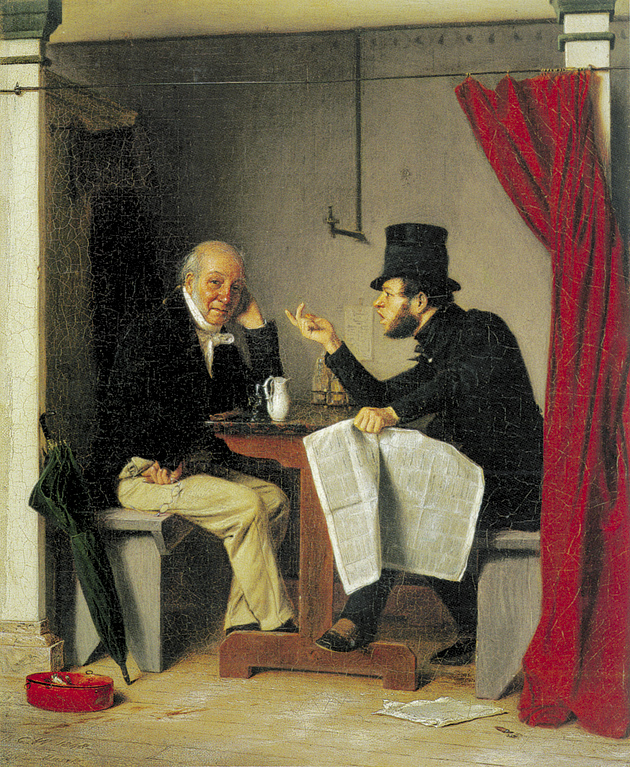“American Stories: Paintings of Everyday Life, 1765–1915,” at the Metropolitan Museum, is a version of a show our museums have done on and off over the years and no doubt will continue to do. Given the Met’s own superb collection of American paintings, though, and its clout as a borrower—there are well-known works here by Winslow Homer, Thomas Eakins, John Singleton Copley, and Mary Cassatt, among others, that one is amazed were lent by their respective museums—few future such exhibitions, it seems, will be as richly stocked.
The point of a show like this, as its installation and catalog make clear, is more social history than art. We are to see how artists mirrored concerns and illusions current in the culture of this or that generation. So, during the period of the Revolution and the early Republic, we follow as artists served their audience with images of industrious and dynamic individuals (this is where Copley’s stunning Paul Revere hangs); and then, from the 1830s on, we look at images—or, as the catalog puts it, “stories”—the culture asked for about the relationship of whites and blacks, or the way backwoodsmen tamed the wilderness. We’re shown how, after the Civil War, women became more visible in public life (the zone where the fashion-conscious young Homer’s deliciously crisp Croquet Scene can be found), city life burgeoned, and, during the Gilded Age, courtesy of John Singer Sargent, the well-to-do took tea.
To a degree, this emphasis on themes is welcome. Our sense of art is so geared to the biographies of artists that it can be a relief to see a show that has little to do with the drama of this or that creator’s life. But treating artists as illustrators of attitudes held by society in various bygone eras has a way of taking the pleasure out of looking at pictures, and it is especially dampening at the Met’s show, where many works have a life of their own.
The theme-based approach is at its worst right at the start, with pictures of people in boats. Here are paintings by George Caleb Bingham (Fur Traders Descending the Missouri), Eakins (The Champion Single Sculls), and William Sidney Mount (Eel Spearing at Setauket), which in each case are among the finest works the artists did. But then there is also a striking oddity by Copley (Watson and the Shark) and strong pieces by Homer. The half-dozen paintings range in time over a century and go in different directions in terms of mood, color, and sense of space. The Met’s curators must have thought they were leading off with a bang, but these powerful works nullify one another.
Most viewers, I think, will be able to put aside the textbook spirit of the exhibition in its latter half, with the works from the late nineteenth and early twentieth centuries. Mary Cassatt’s good-size Little Girl in a Blue Armchair (1878), for instance, jumps out at us, partly because Cassatt catches her young protagonist’s slumped state to a tee, partly because of the artist’s brilliantly offbeat decision to include so much furniture—and furniture all upholstered in the same fabric, and placed so casually—in the scene. There are also wonderfully evocative paintings, succulently brushed in, by George Bellows (of teeming street life), William Glackens (of Central Park under snow), and John Sloan (of the Flatiron area before a storm).
Among these later works, the pairing of Thomas Anshutz’s 1880 The Ironworkers’ Noontime, a scene of young factory hands, many shirtless and self-consciously posing, and Eakins’s Swimming, from five years later, where a group of nude men are arranged with the grace of a classical frieze, is particularly fascinating. Anshutz was a pupil of Eakins, and we see the younger artist taking his teacher’s rapt and almost devotional feeling for the male body into a new realm, where young men interact like so many bumptious yet elegant windup toys.
The paintings in “American Stories” by the chronologically earlier and less familiar artists will be more of a slog for viewers. The catalog authors have done a mighty job of linking these pictures to social currents of the day, but many of the works are simply inert on the wall. Yet there are artists here of real individuality besides Copley and Homer. Ralph Earl’s 1789 portrait of Elijah Boardman, a dry-goods merchant, startles with its sheer monumentality; and its air of folk art, especially felt in the way background details push into the foreground, is extremely welcome in a show that, to its real loss, “favors,” as we read in the catalog, only “refined compositions” and “credible treatment of the human figure.”
A taste of the way that many folk artists bend or distort forms to suit personal expressive needs can be found, however, in another artist here—David Gilmour Blythe, who worked out of Pittsburgh and whose caricatural feel for people is reminiscent of Daumier and Dickens, his contemporaries. Blythe’s haunting Post Office stands out in the exhibition, saying as it does that daily life in mid-nineteenth-century America could prove a furtive, intrusive, and inadvertently comic experience.
Advertisement
But the real discovery for viewers among these earlier artists may be Richard Caton Woodville, an artist from Baltimore who did all his mature painting while living in European cities (and died, at thirty, in 1855). His Politics in an Oyster House and War News from Mexico, two of the best of the few pictures he left, both show one or more people getting carried away by what is being reported in newspapers, while other people in the scenes remain uncertain of what they hear.
On the face of it, Woodville’s pictures are pieces of pure farcical Americana. Like a Preston Sturges movie, they show us to be comprised, as a people, of those born to be bystanders and those born to go ballistic. Yet Woodville’s pictures, taken simply as compositions, are so beautifully thought through, and his feeling for character and gesture is so precise and down-to-earth, that one believes they could be seen alongside masterful small-size, intimate pictures of people from many eras—alongside, perhaps, Gerard ter Borch’s seventeenth-century paintings of young women and their suitors, scenes that, like Woodville’s, seem essentially to be about uncertainty. Woodville’s having brought off such works makes for one of the more absorbing and mysterious stories in “American Stories.”
This Issue
January 14, 2010




